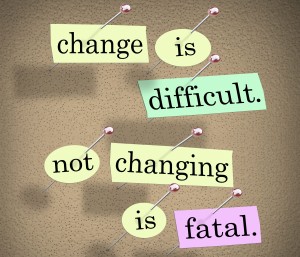Your #Career : Five Things To Do When You’ve Exhausted All The #JobBoards …If your #JobHunt has Stalled, Try One of These Tactics to Get Out of your Rut.
You’re scanning the job boards daily, but there just aren’t any new listings that catch your eye or fit your experience level. But you don’t have to let your job search grind to a halt just because the pickings seem slim.
There are a few other things you can do to keep things moving, even when there’s not much out there.
1. SET UP AN INFORMATIONAL INTERVIEW
Informational interviews are underrated. The goal is to get a hold of someone who works at a company you’re interested in and just learn the inside scoop. They aren’t the one who’s making any hiring decisions, and maybe there isn’t even an open position there that you’re currently gunning for. It’s purely for research and networking.
After you’ve spent some time trawling job boards like Glassdoor, Indeed, and Monster, you’ve probably assembled a shortlist of employers that appeal to you, even if they aren’t hiring right now. And as career coach Sarah Vermunt put it recently, “If there’s an organization you know you’d like to work for, you’d be crazy not to try for an informational interview with someone who works there.” So, she suggests, “reach out to someone who is doing work that is similar to the work you want to do. That’ll give you a true picture of the work–the good, the bad, and the ugly.”
As you plan your next move, these informal conversations can arm you with crucial intel about where the market needs really lie, which organizations are thriving and which ones might actually be pretty toxic, and a few smart ways to position yourself for openings when they finally do crop up.
Read more: Yes, You Need Informational Interviews–Here’s How To Land Them
Like this Article ? Share It ! You now can easily enjoy/follow/share Today our Award Winning Articles/Blogs with Now Over 2.5 Million Growing Participates Worldwide in our various Social Media formats below:
FSC LinkedIn Network: www.linkedin.com/in/fscnetwork
Facebook: http://www.facebook.com/pages/First-Sun-Consulting-LLC-Outplacement-Services/213542315355343?sk=wall
Google+: https://plus.google.com/115673713231115398101/posts?hl=en
Twitter: Follow us @ firstsunllc
Question: Want the ‘the best/current articles/blogs on the web’ on Job Search, Resume, Advancing/Changing your Career, or simply Managing People?
Answer: Simply go to our FSC Career Blog below & type(#career, #leadership, #life) in Blog Search: https://www.firstsun.com/fsc-career-blog/
What Skill Sets do You have to be ‘Sharpened’ ?
Continue of article:
2. UP YOUR LINKEDIN GAME
This one is a no-brainer. When you send out a job application, you’re knocking on employers’ doors; when you optimize your LinkedIn presence, you’re inviting employers to knock on yours. Scan your LinkedIn profile for any incomplete fields, discrepancies, overwritten chunks of text, extremely basic skills, and meaningless industry jargon–all of those things are turn-offs to recruiters and need to go.
Take a little time to personalize your profile so it highlights what’s genuinely unique about your experience. For instance, if you’re a software engineer, your headline should specify what kind, and your skills field should list all the languages and coding tools you know. At the same time, balance out any the human side, too, so you don’t come across as a soulless robot with only great technical chops. Explain what you’re passionate about and what types of problems you’ve solved (and why those wound up helping your team, your organization, or your customers).
Specificity matters, but so do soft skills like emotional intelligence–no matter what your role or industry.
Read more: If You Can Only Spare 15 Minutes A Week For LinkedIn, Do This
3. GO TO A NETWORKING EVENT
I know–everyone hates hearing advice like this. But when you’re coming up dry in your search for openings, it doesn’t hurt to hit up a networking mixer–even one that you know will be short on leads. The reason? When you’re looking for a job, you need to actively seek out opportunities to practice discussing your experience, professional goals, and passions.
So even if it’s pretty much guaranteed that you aren’t going to meet your next boss at that networking event, the exercise in introducing yourself to strangers and talking articulately about your career is a valuable one. Feeling iffy about it anyway? Grab a friend or coworker and make networking a team sport.
Read more: How I Learned To Stop Hating Networking Events (Mostly)
4. CHECK YOUR SOFT SKILLS
Recruiters are interested in your people skills, not just your technical know-how. As Susan Vitale, chief marketing officer for iCIMS, recently told Fast Company, “Hard skills are what you do, and soft skills are how you do it.” And some of the top capabilities in that category, according to Vitale and other talent professionals in the space, include adaptability, problem solving, and verbal communication.
Some job seekers who repeatedly get called in for job interviews but miss out on offers may find that they’re falling short on some of those key soft skills. It’s sometimes easier to nail down a candidates’ technical capabilities before meeting them; soft skills are harder to suss out. So giving recruiters and hiring managers reason to feel confident that you’re emotionally intelligent in addition to being a world-class marketer is one way to get a leg up when new openings finally do get posted. In the meantime, take a few minutes to dial up those soft skills on your resume–here’s a handy formula for figuring out how.
Read more: These Are The 5 Soft Skills Recruiters Want Most
5. CHANGE YOUR THINKING ON JOB-SEARCH DEADLINES
One of the reasons a long, mostly fruitless job search can feel so frustrating is because the outcome you’re looking for–a really great job offer–isn’t something you can bring about all on your own. No matter how badly you might want a new job by next month, there’s nothing you can do single-handedly to guarantee you’ll get one by then. As The Muse’s Alison Cardy explains, “When you tie a deadline to something that’s not within your power, you set yourself up to feel defeated if it falls through.”
Read more: Two Simple Tricks For Staying Positive In A Long, Hard Job Search
Looking out for your mental health is crucial at times like these, when positivity can be in short supply. One trick Cardy suggests is rethinking the way you’re setting goals and deadlines as a job seeker. So commit to sending out 10 job applications over the next two weeks, for example, or to grab coffee with three contacts by the end of the month. “By connecting the deadline to your personal efforts,” Cardy says, “you give yourself the opportunity to feel successful just by meeting it–and that confidence boost can mean a lot during a tough search.”
















